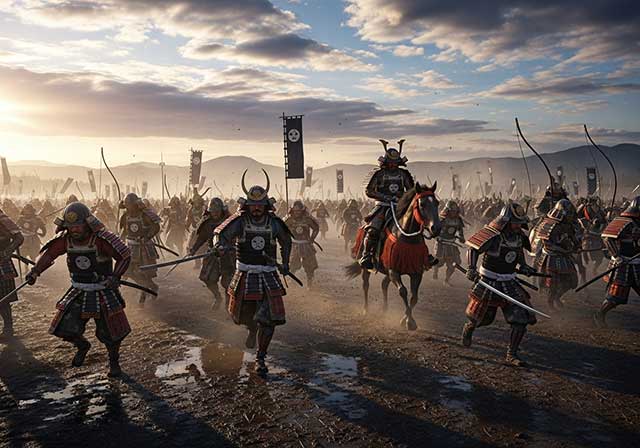
After Kusunoki Masashige's death in the Battle of Minatogawa, his son, Kusunoki Masatsura, continued his work supporting the Southern Imperial Court in the Nanboku-chō period war. He took on his father's legacy not only as a duty, but also as a way to remain faithful to the ideals for which Masashige had given his life.
In 1347, Masatsura conducted several successful campaigns against supporters of the shogunate and the Northern Court. His military operations covered the provinces of Kii, Izumo, and Settsu. In these campaigns, he managed to strengthen the position of the Southern Court and show that his father's legacy lived on in him.
Masatsura's victory at Sakainoura is particularly noteworthy. An army led by Hosokawa Akiuji was sent there to capture him, but Masatsura's troops managed to defeat the enemy.
In 1348, the shogunate assembled a powerful force and sent it to the city of Yoshino. This was the location of the temporary imperial palace of the Southern Court, and the threat was deadly for the emperor and his entourage.
Masatsura realized that it would be impossible to defend the emperor's residence under such conditions and decided to lead his troops out to meet the enemy. At the same time, his ally, Kitabatake Chikafusa, headed towards Izumo, drawing part of the enemy's forces away with him, thereby easing the pressure on the Southern Court.
According to legend, Masatsura challenged the leader of the shogunate's forces, Ko Moroyasu, to a personal duel. He almost won the battle, but was struck by an enemy arrow, ending his career as a warrior.
According to other sources, Masatsura fought alongside his warriors. When the shogunate army began to gain the upper hand due to its numerical superiority, he retreated to the Nyoirinji temple. There, Masatsura composed a death poem and, following samurai tradition, committed seppuku.
Victory went to the Northern Court army. However, the Southern Court emperor and his entourage managed to escape from Yoshino. Thanks to this, the resistance was not broken, and the confrontation between the two courts continued.
See also
-
The Siege of Hara Castle

The Shimabara Rebellion of 1637–1638, which culminated in the siege of Hara Castle, was the last major uprising of the Edo period and had serious political consequences.
-
Battle of Tennoji

The confrontation between Tokugawa Ieyasu and Toyotomi Hideyori during the “Osaka Winter Campaign” ended with the signing of a peace treaty. On January 22, 1615, the day after the treaty was signed, Ieyasu pretended to disband his army. In reality, this meant that the Shimazu forces withdrew to the nearest port. On the same day, almost the entire Tokugawa army began filling in the outer moat.
-
Siege of Shuri Castle

The Ryukyu Kingdom was established in 1429 on Okinawa, the largest island of the Ryukyu (Nansei) archipelago, as a result of the military unification of three rival kingdoms. In the following years, the state's control spread to all the islands of the archipelago.
-
The Siege of Fushimi Castle

Fushimi can perhaps be considered one of the most “unfortunate” castles of the Sengoku Jidai period. The original castle was built by Toyotomi Hideyoshi in the southeast of Kyoto in 1594 as his residence in the imperial city.
-
The Siege of Otsu Castle

The siege of Otsu Castle was part of the Sekigahara campaign, during which the so-called Eastern Coalition, led by Tokugawa Ieyasu, fought against the Western Coalition, led by Ishida Mitsunari. Otsu Castle was built in 1586 by order of Toyotomi Hideyoshi near the capital Kyoto, on the site of the dismantled Sakamoto Castle. It belonged to the type of “water castles” — mizujō — as one side of it faced Japan's largest lake, Lake Biwa, and it was surrounded by a system of moats filled with lake water, which made the fortress resemble an island.
-
The Siege of Shiroishi Castle

The siege of Shiroishi Castle was part of the Sekigahara campaign and took place several months before the decisive battle of Sekigahara. The daimyo of Aizu Province, Uesugi Kagekatsu, posed a serious threat to Tokugawa Ieyasu's plans to defeat the Western Coalition, and Ieyasu decided to curb his actions with the help of his northern vassals. To this end, he ordered Date Masamune to invade the province of Aizu and capture Shiroishi Castle.
-
The Second Siege of Jinju Castle

During the two Korean campaigns of the 16th century, the Japanese repeatedly had to capture enemy fortresses and defend occupied or constructed fortifications from the combined Korean and Chinese forces. Among all the operations of that time, the second siege of Jinju Castle is considered the most interesting from the point of view of siege warfare.
-
The Siege of Takamatsu Castle

The siege of Takamatsu Castle in Bitchu Province is considered the first mizuzeme, or “water siege,” in Japanese history. Until then, such an original tactic had never been used.

